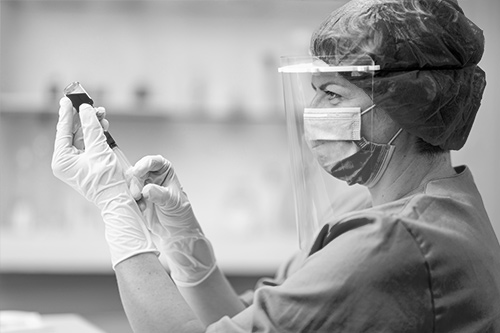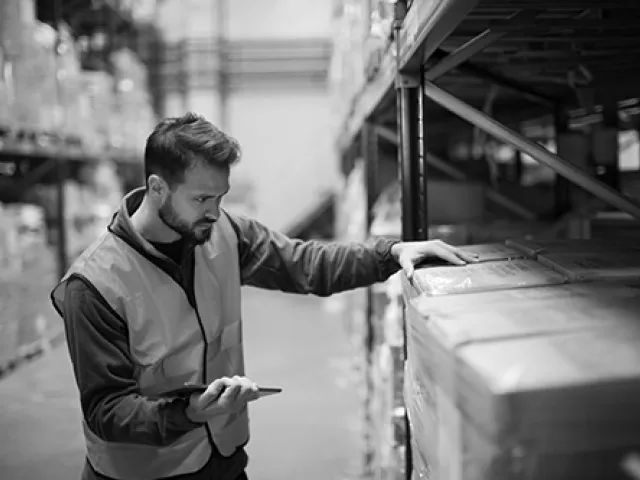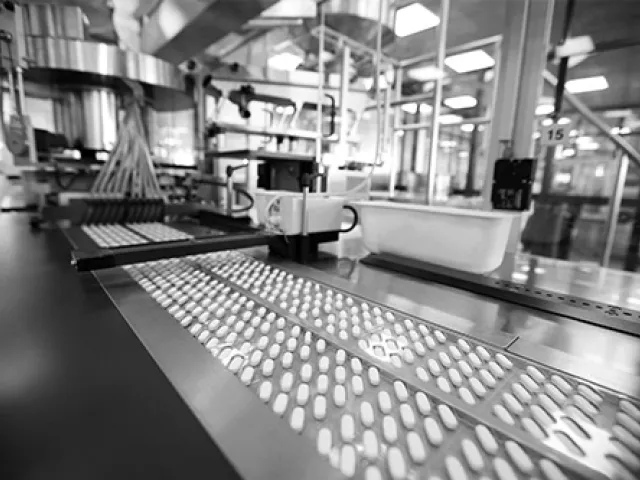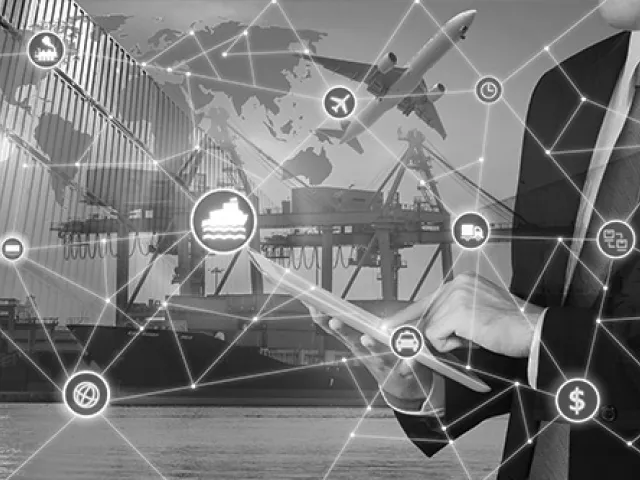Table of contents
Key Takeaways
- The industrial revolution is over and the digital age of supply chain has arrived.
- Making the switch from the industrial age to the digital age requires a complete re-engineering of supply chain processes.
- Sensors and other IoT technologies can help you predict problems before they happen, and that results in financial savings.
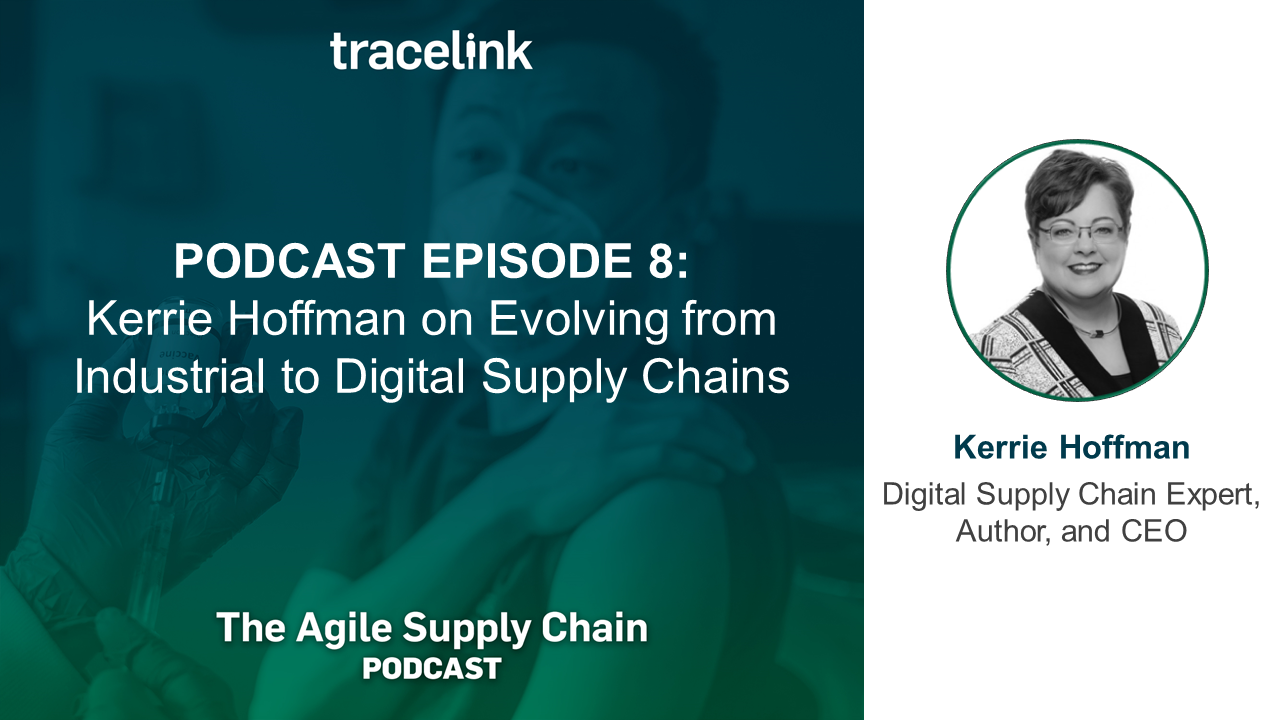
Digital supply chain expert and CEO Kerrie Hoffman joins Roddy Martin to discuss how the pharmaceutical industry is moving from an industrial age to a digital age—and how COVID‑19 has proven that you may be better prepared for this transformation than you think.
Transcript:
Roddy Martin: Kerrie, welcome to another instance of this TraceLink's "Thought Leadership" series. It's really a pleasure to have you. I've known and worked with you for many years. I jokingly say that whenever I did a call with Kerrie Hoffman, I had to have my ducks as an analyst in a row.
It's really a privilege to have critical thinkers like that on the series. As CIO, run outsourcing operations run big industrial CIO operations and not being digital transformation, you have a great band of experience I'd love to tap into.
Introduce yourself and talk a little bit about those roles, and what those takeaways have been around, especially in the lack of agility and resilience that we're seeing in supply chains because that is the elephant in the room right now. Over to you.
Kerrie Hoffman: That, absolutely, is the elephant [laughs] in the room. Thank you for having me, Roddy. I appreciate the opportunity. It's always fun to have a conversation with you. Now, I'm a CEO of Hoffman Digital. It's a collection of companies. One of those companies is Get Digital Velocity. We specifically work on digital transformation in roadmaps.
Like you said, I have a lot of previous experience in corporations. I held a CIO roles at several business units of Johnson & Johnson and Johnson Controls. That was over 20 years of experience in those two companies. I also spent 10 years in a hospital.
I have a unique perspective. I started as an expert troubleshooter on lab analyzers in the hospital. Then I joined Johnson & Johnson in sales. I was selling a complex product and then I went into IT in the same business unit of Johnson & Johnson.
Then I started creating technology‑enabled solutions for that same business unit. I have this unique perspective of being very customer‑focused. I think that customer focus is one of the most important things today in a digital transformation.
Roddy: It's interesting. If you look at the logo on my left or right shoulder, whichever way you look at me, it's all about the patient‑driven supply network. It's kind of an amusing play on the old P&G consumer‑driven supply network.
The CIO of P&G, who's now the CIO of Merck, Alessandro De Luca, came up at our conference and said, "Ah, this is about the patient‑driven supply network."
I'm so glad that you had that hospital experience, because I think if there's one thing that has changed is that the outcome that we're driving for in the supply chain ‑‑ it's not individual players like a logistics provider or a drug manufacturer.
It's actually a patient outcome, and it's going to become more intense as we go to cell and gene therapy and personalized medicine.
Let's talk about digital, because I think digital and digital operating models are the game‑changers. I think the questions you teed up with ‑‑ what is digital, and how do you convince a leadership team that the way they've been working in the past can actually be fundamentally transformed if they think about a digital operating model? Over to you.
Kerrie: This is the question of the day. What is digital? Everybody has a different answer. I think it's important to look at some context when we're talking about digital.
The context that I would bring in ‑‑ and I feel very strongly about this ‑‑ we have exited the industrial age, and we have entered the next age. I call business in the industrial age traditional business, and I call business in the next age that we're in digital business.
The characteristic about moving from one age to the next is that the way that business is conducted is completely different. The thing that's completely different about a digital business is something that I call extreme customer centricity.
Traditionally, companies work from the inside out. An order'll come in and it'll go through a series of steps internally, and then you spit something out the other side.
Same thing with a medical business. A patient comes in. You do a whole bunch of tests. You collect samples. All this stuff happens internally. Then you get a result and you address the patient. That's a very inside‑out approach.
Extreme customer centricity means it's outside‑in. The customer or the patient is at the center of everything, and no matter how big your company is, every person has a touchpoint with that customer or that patient if you're a digital business.
The first thing is that extreme customer centricity. You know your customers' issues so deeply that you're able to solve them quickly, and you'll likely solve them by adjusting your products, your services, your supply chain in order to solve those issues. You can't do that unless you're a digital business. There's like three components beyond this extreme customer centricity.
The first one is around talent, and there's this abundance of talent out there, especially if you're using alternate sources of talent, so things like freelancers, the gig society but also partnerships.
Partnerships get really interesting in a digital business, because it goes beyond two companies partnering together. You partner with universities. You partner with your customer. You partner with competitors. There's a whole series of partners that are part of figuring out how to solve those customers' issues.
The other thing with talent is you augment talent with technology. I'm a big believer in augmenting talent with artificial intelligence. I think the main reason for doing that is to stop the mundane tasks from being done by a human ‑‑ automate those ‑‑ but free up people's time to spend with the customer or the patient.
Two other pieces. One of those is digital operations. This is where in order to have every single person touch the customer, you work in small cross‑functional teams, and those cross‑functional teams are focused on a micro‑segment of the customer.
What happens is your operations become very agile and very flexible so that you can solve those customers' issues quickly.
Roddy: That's an interesting point, because if you remember, we've seen a couple of these micro‑dot, dot, dots ‑‑ microfinancing, micrologistics. It's the first time I've heard this in the context of digital.
I think that it's a very real proposition, and I think what makes this so exciting is, when you understand more about the patient. Well, put it this way. We're at a T‑junction where we could not carry on the way we were, right?
Kerrie: Absolutely.
Roddy: I think the pandemic, in a sense, did us a service by showing that, "Look, this is going to break if you push it to the limits." You can't rely, as you say, inside‑out on just producing millions of things for millions of people, flooding the market, and hoping that everybody's going to get what they need.
We got to the break point. Twice, it became too much. Just the infrastructure implications overpowered us. This is why I love the idea that John Gattorna always talks about of outside‑in, demand‑driven segmentation.
When we get down to a patient community of 10 people, you can't ship your product everywhere. You got to ship it to those 10 people, or else they're not going to get what they need to have. I think that's the big advantage.
Now, you could never do that in a traditional IT sense. I think inside‑out to outside‑in, extreme patient centricity. I love that. I think getting the business to understand the constraints and the opportunities of the digital operating model and the way they worked in the past is fundamental.
What are the learnings as you go through companies? Because I can bet you from my own experience, they don't sit there and say, "Kerrie, what a wonderful idea. We're just going to flip the switch and become a digital business tomorrow." What kind of pushbacks do you get?
Kerrie: This is really interesting, Roddy, because this is one of the silver linings of the pandemic, because prior to the pandemic, a lot of people would argue with me. "My business doesn't need to be digital. Not all businesses can be digital."
It's kind of like the argument of "Not all projects can be agile." I'm like, "No, all projects can be Agile. All businesses can be digital." Before the pandemic, people would argue with me.
The pandemic's really squashed that argument, because a little thing like ‑‑ and I say a little thing, but it was a big thing for so many companies, of everyone having to work at home, and everybody did that in two days, three days, to two weeks.
I haven't really talked to companies that have gone beyond it taking them two weeks to shift to everybody working from home. When I talk to CIOs about that, I get a lot of comments like, "Wow, we really surprised ourselves. If you would have told me that I had to have 100 percent people working from home, first of all, I wouldn't have believed it."
Because there is too many senior management that didn't believe in it. "Second, I wouldn't have created a 6 to 12‑month project to make sure it would get done and it would get done in the right way with little interruption." The reality is, they did it in two weeks.
Roddy: Right, because they didn't have a choice.
Kerrie: They didn't have a choice. With little interruption. What they learned was that...This learning goes beyond IT. The IT learning, but really senior management across, doesn't matter what function you are, learned this. Wow, the technology was more ready than we thought. We didn't break our internal systems. We didn't break the Internet.
It slows down occasionally for a few people, but we didn't break it. It all works. The technology is mature enough. We were forced to do it. One of the biggest obstacles is mindset to shifting to digital. When everybody had the mindset that was like, "Oh, my God. We have to do it. Let's go. Let's do it," it got done in two weeks.
Roddy: That's fantastic. To take a leaf out of two of your ex peers, and to add a leaf into the chapter from Holly let me just make three points. You're going to smile. Yesterday we had Mike Whitman on a recorded webinar. Mike said, "You can't have agility without reliability." Which I think was absolutely profound.
Kerrie: Absolutely.
Roddy: You also remember Paul McKenzie from J&J , who is now the COO of CSL Behring. Paul spoke about, he has these reliability rooms which he unashamedly stole from J&J at CSL Behring.
Where they look every day at what were the smoke signals that happened in operations, and which smoke signals do we need to go and respond to quickly, and understand how bad each of those smoke signals are if we're looking at continuous supply to a patient.
The third one was professor Holly who said, "We now have the challenge of hyper‑sensitive and hyper‑responsivity challenges." If we take that, we say, "You would never be able to do that without digital capabilities."
The point you make about outside in is, let's understand the business walking back from the patient to supply through the hospitals you've been part of, through the outsourced operations you've been part of, through actual manufacturing operations, and figure out, how do we get the right product to the right place at the right time?
What other challenges do you think that you experience? What other points would you like to share with the audience in terms of this digital transformation?
Kerrie: I think you nailed it with, you start with the patient and work backwards. That's the extreme patient centricity, is starting with the patient and then going backward through the supply chain to make sure you can do what you need to do. I had mentioned, to accomplish this extreme centricity you need three things. Talent, digital operations, and the third one is technology.
You can't fight the fact that you need the technology. Every time we move from one age to the next, there is a trigger. The trigger for the industrial age was the machine. It was many different machines replacing manual work. The trigger for this next stage is an exponential growth in technology. It actually started in the year 2000.
That's when some tech companies started using the exponential technology. Salesforce is a great example, very digitally native company. It started around the year 2000. The technology became mainstream in 2007. Here is the thing. A modernly architected technology, these exponential technologies that are coming out, are very different.
They're architected very differently than traditional technology. People still will argue. Very technical people will say, "Oh, well, that's not any different than so I was 30 years ago." I'm like, "Actually, it is different. It's a lot different." [laughs] We won't go through how it's different because that just gets too technical, [laughs] but it is different.
To do what you're saying, those smoke signals from J&J, "We looked at all the smoke signals." Well, now you can look at thousands and hundreds of thousands of smoke signals if you are putting tags on all the things that are in your supply chain. If you're doing IoT on the shop floor, now you can change over your manufacturing line just at a drop of a dime.
You can do it very quickly, it's automated. You can actually have a mass production line of a CPG product as an example, a consumer packaged good, and you can customize it in line because it's automated. It's programmed in. In order to sort out all the smoke signals from all the tags you're putting everywhere, that's where artificial intelligence and machine learning comes in.
The humans don't have to consume this massive amount of data, you have the artificial intelligence consume it, correlate it, and spit out the smoke signals that are the most important.
Roddy: That brings me to a really important point. I am a little disappointed that I think...It's a general comment that supply chain leaders still see the analytics discussion as a technology one. They haven't really embraced the value of analytics. I mean, you sit in an ironically different role to what you sat in before.
Previously, as the CIO, I would say, "Kerrie, as CIO, I want you to give me all the data for these events that happened in the past. You said, "Hey, that's pretty straightforward. We'll build a report. Those are questions I knew you were going to ask me at some or other point in time." However, today as digital carrier, if I may call you that.
Kerrie: [laughs] You may.
Roddy: You're saying to business leaders, "Think about questions that you never even thought you would ask. That you never thought you would get answers to." Because we can't explain analytics in that parlance, they immediately think you're trying to catch them out on a technology question.
In terms of educating business executives on analytics and taking them into asking questions and thinking about things that you'd never thought about before, is there any magic nugget or super sauce that you can share with us?
Kerrie: Let's see. A nugget in there? It's so important to get a lot of data sources coming in, right? It's so important to do that. It's so important to have some automation behind that in order to start to see or present trends to you.
Because what happens is, when you present anyone, executives, frontline workers, middle management, with data that is showing you insights, they're going to now see things they never saw before or didn't even know were happening. Like what you said, this is when questions they never knew they needed to ask, they can start to ask because they see these insights.
Roddy: When you work with those business executives, you obviously approach them on a very ‑‑ I hate to use the word simple and it's not basic either, this is not meant to be patronizing in any way ‑‑ but opening those doors to the possibility of analytics has to be the one biggest opportunity for digital because you're augmenting technology with people. Analytics is not cutting people out of the loop.
Kerrie: Not at all.
Roddy: That's putting people into interpretive roles. It's taking those trends you speak about and adding insights to them so that you prompt the leadership team to say, "Did you know that this was happening?
I love telling the story, which is public domain, about P&G investigating a billion dollars' worth of stockouts and giving the business four billion dollars of returns back. You ask, "How on earth is that possible?" They will tell you they walked back from the shelf to supply and they found problems they didn't even know existed.
With digital, you can do that because there's masses of data. You've just got to feel and find out how you get your arms around it and explore it to see where that four billion dollars is hiding.
Kerrie: Absolutely. It's the same thing with preventative maintenance on big pieces of equipment. This could be an analyzer in the lab, this could be a piece of HVAC equipment in a giant building.
When you start putting sensors and tags and more sensors and tags in that piece of equipment and then start collecting that data and trending that data, so you're looking at graphs of data based on certain sensors, you can predict when something's going to break before it breaks.
It ends up saving hundreds of thousands of dollars on a major piece of equipment because instead of it breaking, you are figuring out the things that happened before it breaks and then you're doing preventative maintenance on it.
Roddy: And looking for the patterns.
Kerrie: Right. You're moving the human up the food chain of data. This is the key. Because instead of, what do we spend our time on in the past when we were building big data lakes or data warehouses? Cleaning the data. There's ways to automate that now. Then what will we spend our time on? We spent our time on graphing the data and trying to look for trends.
We'd have a hypothesis in our head and we would say, "I'm going to test that hypothesis." Now with automation and artificial intelligence, machine learning, it can do all that work. It can do all the work, and it can show you the trends. It can show you the spikes.
Now, the human has moved up the food chain and is only looking at the spikes at the anomalies, and that's where the issues are that get fix that end up saving millions of dollars.
Roddy: I love that point of view because one of our big focuses on the TraceLink platform is to use the platform to capture issues across the end to end business, raise the visibility of those issues, and analyze them so that you can see where the real fires are.
You've given me a new nugget thought, which is, maybe as CIO, you had to take the profit to the mountain. Today in digital, you can actually take the mountain to the profit.
You're taking the ready built mountain to the profit and saying, "Look what I got. Let's just use it for business value." I think that's a serious discontinuity in the way we've always seen IT and the way we see oriented IT going forward in the future.
Kerrie: The serious change for it too is to get so much closer to the customer.
Roddy: Is that a big challenge that you find CIOs are dealing...? Is it just a new generation of CIOs and the 55 years ‑‑ and we're all giving away our ages here ‑‑ but the 55‑year‑olds are retiring and becoming real smart consultants and the new CIOs are born with technology in their hands, or is that not the case?
Kerrie: I still feel like a lot of CIOs are a little bit behind. They have issues, especially if we're talking older companies. Companies who are at least 30 years old or more, which are a lot of companies. [laughs] They've got a lot of legacy technology. They have all these legacy problems that they feel like they need to solve, and they're used to spending their time there.
The reality is, most of that legacy stuff can be outsourced. I did a lot of outsourcing, but it isn't outsourcing just to save money. It's outsourcing to free up time so that you're spending time understanding new architectures and new technology. I feel like I have to show them the way.
It's totally and completely possible, I did this in a $15‑billion business unit that had 33 brands of ERP and hundreds of instances, and we had a problem with our customers, and our customers saying that we're difficult to do business with.
Of course, we were difficult to do business with because most of our customers were big and they ordered from multiple product lines within the business unit, and they had to give us multiple orders, and they got multiple POs, and they couldn't figure out where their product was. It was a mess.
A new president came in and said he needed it fixed in a year. It's like, "That's not possible if you do it the way you've always done it." Which was, we'd have to put in a single instance of ERP. We couldn't do it that way. This was seven years ago now. So what do we do?
We put a digital data layer over the top of the legacy. We built a platform as a service over the top of it, just with major vendors that we were already using, and we created a single order single invoice in 18 months. Not 12. He wanted 12 months. We did in 18 months, and it was all done in the cloud layer above.
The data layer was not just about reporting and data warehousing. It was about being able to virtualized transactions and connect those layers. We didn't have to replace the ERP but we also didn't have to touch the ERP. It is absolutely possible.
Roddy: I think the one point that I'm going to make as we close is I love your, "We moved from industrial business to digital business." It is that significant. It says, "I'm about to go on to an ISP global webinar around the future pharma supply chain."
I'm going to quote you on that because the topic on the table is this, evolution or revolution. You don't get from industrial to digital in an evolving way. You can do lots of little digital projects.
Kerrie: Got to go for it.
Roddy: You have to fundamentally re‑engineer and go all the way to digital operating model. Any last thought that you'd like to leave the audience with, Kerrie? It's been an absolute pleasure having you. What closing thought would you like to share?
Kerrie: My closing thought is going to be very similar to yours. I think it's so important. We keep hearing about industry 4.0, industry 5.0. No. The industrial revolution is over. Those things are different enough that we are in the next age.
I call it the next age because when I try to name it, people would argue with me about what it was named. That wasn't the point. The point is we are in the next age. The way that work is done in the next stage is completely different. You have to transform to be a digital business.
Roddy: I love that perspective. On that closing, wise thought, thank you very much, Kerrie. It's been a pleasure to talk to you and have you on the TranceLink Thought Leadership Network. Thanks for making the time.
Kerrie: Thank you, Roddy. It's been a pleasure.
Return to: The Patient-Driven Supply Network



